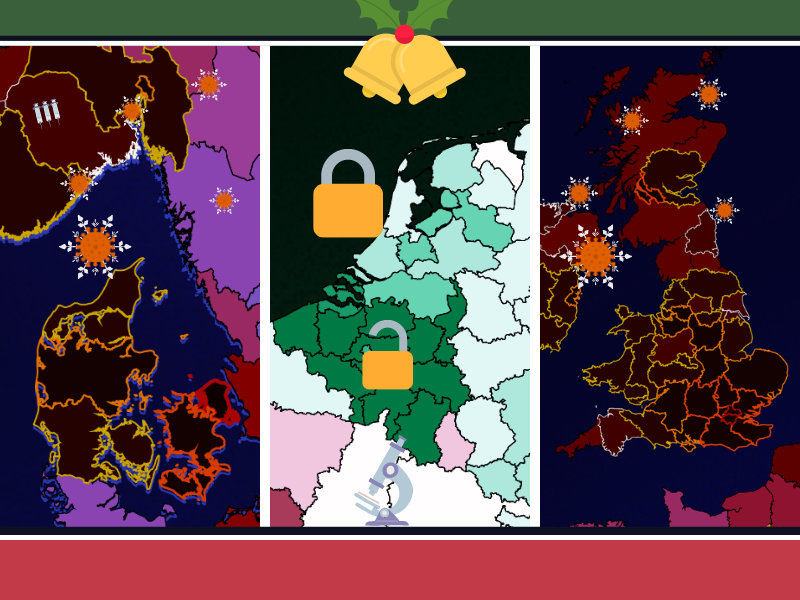
Will the Delta variant make it through the New Year? Since the advance of Omicron, this seems extremely unlikely. In the run-up to Christmas, Europe is, for the second year in a row, the scene of the highest infection rates on earth. To cope with the upcoming infection peak, governments are increasingly tightening the reins. In Sweden, seating is mandatory in restaurants, Belgians are no longer allowed to go to the cinema, and in Spain a face mask is mandatory at every public indoor and outdoor location. Nowhere does this go as far as in the Netherlands which has been locked down almost completely since Sunday. Why is this?
Yet the results of the first studies of the effects of Omicron appear to be cautiously hopeful. At least for individual patients. Experts from the US, South Africa, Denmark and Great Britain are in general agreement that the risk of hospitalization is much lower. Nevertheless, lower does not equal zero. That even moderate rates can create unmanageable problems for healthcare systems has been borne out by millions of corona patients over the past two years.
The problem with Omicron is that the vaccines – especially without a booster shot – do not work as well as they should, leaving hundreds of millions of Europeans, young and old, susceptible to another viral assault. Because one thing is now certain: this variant is going to cause extremely high rates of infection. The consequences of that need to be exceptionally mild to avoid overburdening ICUs.
Take note of the slider chart below for Denmark and the United Kingdom. This is where this variant is now dominant. Just four weeks ago, our continent was still dominated by Delta.
Exponential misery
Because of its completely different characteristics, it is as if the rules of the game for this pandemic have been completely thrown out of whack. Copenhagen and London were given the questionable premiere early this month. In just seven days, Omicron infected around 2,000 out of every 100,000 inhabitants there, 2 % (!) of the population. Meanwhile, it has also seized control in that other British isle, and in Norway. Spain and France seem to be up next on the list.
Actually, the slider chart shows the prevalence of two pandemics at the same time. Where is Delta still sweeping through? And where is the rise of Omicron imminent? This becomes clearer with this last-week-versus-this-week chart. Since Omicron is spreading much faster, this map also reveals regions colored dark pink. In the green regions, the number of new reports of infections fell. The longer-term trend can be seen on the heat map.

Full stadiums and deserted shopping streets
Although rules have been toughened up practically everywhere, nowhere did this go as far as in the Netherlands. Quite remarkable since our country does not really stand out from the crowd when it comes to infection rates. So why are other Premier League stadiums still full and the Dutch Premier League has had to play without an audience for weeks? Even in the decidedly more cautious Denmark, a drink in the pub is still possible with a few extra rules in place.
Purely on the basis of the incidence rates, the baseline position of the Low Countries actually seems to be above average. Even on the slider chart comparing the situation with four weeks ago, the red areas are virtually non-existent. Is this proactive forward thinking, frenzied alarmism, a tactful decision with the arrival of a lecherous Omicron on the horizon, or the only remaining option because the solutions toolbox is empty?
Appearances are deceptive
Based purely on the number of infections, the Netherlands is not in such a bad state by any means. Yet the decline among the Belgians is much steeper even though they took far fewer drastic measures. Due to a combination of factors, this is not necessary now either. The waters are not as choppy for the Belgians as they are for their neighbors to the north. And that is not entirely on account of the extensive ventilation in all public buildings that has been compulsory there since this summer.
Is a decrease in the number of reported cases the same as a decrease in the number of infections? Not necessarily. The number of ‘infections’ tallied in the incident lists and maps is a consequence of testing capacity. Those who test sparingly will also find few new corona cases to include in their statistics. Yet this does not mean that the virus has spontaneously disappeared. On the contrary: the danger in countries that do not test enough is that an overview of the spread is lost.
How is it possible that in the Netherlands, the percentage of positive tests has been well over 20 % for weeks, while the number of new cases reported has almost halved? According to the WHO, a country should scale up if the norm value of 5% positive tests is exceeded.
Dubious testing capacity
Between 6 and 12 December, 453,802 corona tests were administered in the Municipal Health Services (GGD) testing lanes, according to data from the Netherlands Institute for Public Health and the Environment (RIVM). This may sound like a lot, but that’s often the case with large numbers. How much is this really? Not very much if we compare the figures of the Danish Statens Serum Institut. Their data dashboard shows how in the Scandinavian country, which has only 5.8 million pairs of nostrils, a test swab went up a nostril 244,650 times. In one week? No, in a day. In week 50, that figure was nearly 1.5 million(!)
Moreover, to be able to keep up with Omicron, over the past four weeks, the Danes scaled up their testing capacity by another 400,000 PCR tests per week. Exactly the opposite has happened in the Netherlands. Testing is now more often done at home using a commercial rapid test that is not officially reported. In one month, the number of PCR tests performed fell from around 650,000 in mid-November to just over 453,000. Does this make us the worst kid in the class? Well if Our World in Data is to be believed.
For every head of the Dutch population, two Belgians, four French and no less than thirteen Austrians get tested in a testing lane of their respective government agencies.
Blind trust
Why do some countries test more? This is not only to track infected individuals, but also to monitor the spread of the virus in society so that prompt precautions are instigated in policy decisions and incisive track and trace measures can be taken to detect and stamp out outbreaks.
Partly because of the inadequate testing capacity, the track and trace policy never actually got off the ground here, any countermeasures were hampered by a heavy mist of dissensus, and action was systematically taken too late at a time when hospitals had already been teetering on the brink of Code Black for weeks. Because this left no capacity to cope with the new Omicron uncertainties, the government hit the draconian emergency brake on Sunday.
However, the evening lockdown, the convenience of home testing and oxygen tanks to keep hospital beds freed up could not prevent the risky balancing act from suddenly tipping over in the week before Christmas. The Netherlands gambled and lost. Omicron or not. This would never have lasted long, incidentally, because the other elephant in the room is beginning to draw more and more attention. If you open up a newspaper, you might notice that there have been a lot of family-related death notices in it lately.
In the third week of December, there were another 950 more deaths than usual. Whether this is the result of the boosters being delayed, deferred healthcare that should not have been postponed any longer, or a shortage of hospital beds or healthcare personnel? The Netherlands also reported a 30% above-normal mortality rate in the weeks before. This has made us the highest in Western Europe for some time now. It is conspicuous.
Code Black Christmas
Only Austria comes anywhere near the excess mortality rate in the Netherlands. It was Code Black there last month, which left the government with no other option than to close down society for three weeks. In the meantime, an upscaling of the testing capacity, a very strict 2G policy, compulsory quarantine for winter sports enthusiasts and a significant ramping up of the booster campaign are supposed to prevent any further worsening. Since then, things have picked up a bit there, the toughest restrictions have been lifted and they think they can cope with a viral Christmas hit.
Although the role of Omicron in the Netherlands is still limited, we are heading into the Christmas weekend with the heaviest restrictions in all of Europe. How limited exactly? It’s hard to tell with the limited testing capacity and meagre germline surveillance. The overview of the spread has been completely lost with sky-high excess mortality rates as the dismal and utterly explicable outcome. What Dutch waters have been unable to do for decades, Delta did to the land of the Delta Works within a matter of months. Next week, its successor will take over. Hopefully, this dominant Covid variant will have more mercy on the builders of the Delta Works than its callous cousin with the same Greek letter whose days are now thankfully numbered.
In any event, the new Dutch cabinet is starting the new year in good spirits for the next round. How exactly do they intend to get the country out of the corona crisis? No idea. There is a lot that the Netherlands is not willing to do. But at any rate, not a 1G policy like in Portugal, nor a 2G policy like in Austria, no outdoor face masks like in Spain, no ventilation in the hospitality sector like in Belgium, no obligatory quarantine hotels like in Great Britain, no FPP2 masks like in Germany, no large-scale testing like in Denmark, no alcohol ban like in Norway, no compulsory seating in the hospitality sector like in Sweden, no compulsory vaccination like in Italy, no compulsory face masks in school classrooms like in France and also, no smaller school classrooms like in Finland.
When the corona policy of a country consists mainly of debates about the policies that you do not want, only one option is left: the hard, all-encompassing lockdown like in the Netherlands. Which absolutely no one wants.
So, what does the Netherlands really want? Boosters! Because after a three-month delay, upper arms are finally getting a third shot. But we still have a very long way to go to catch up with the rest of Europe. Which, given our experiences with our slow start at the beginning of this year, will most likely work out just fine in the end. So let’s not let that excess mortality rate throw a spanner in the works, the Orange nation should even do a little better at the European Championships in December!
Merry Christmas everyone! Don’t make it too miserable, but definitely not too merry either!








